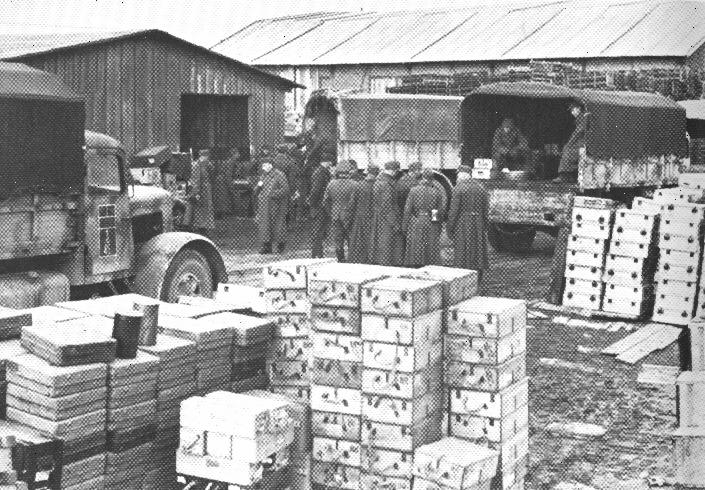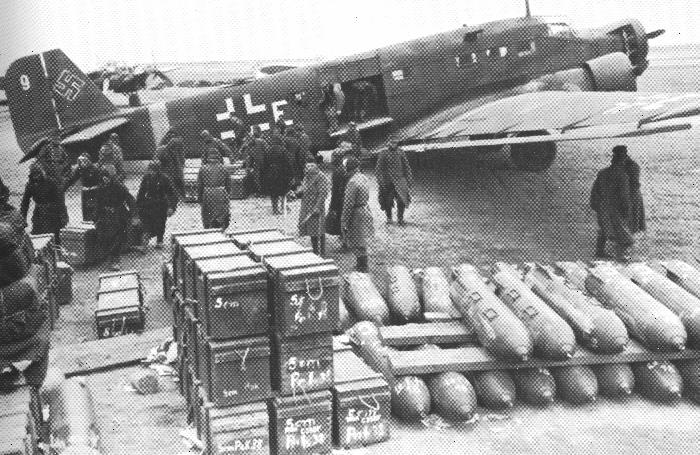Source :
Joel S. A. Hayward, STOPPED AT
STALINGRAD:
THE LUFTWAFFE AND HITLER'S DEFEAT IN
THE EAST 1942-1943.
Lawrence, KS: University Press of
Kansas, 1998.
Second ed 2001. ISBN: 0-7006-1146-0.
http://www.joelhayward.org
Introduction.
When Stalin launched
Operation
Uranus on 19 November 1942, Richthofen's Luftflotte 4
possessed enough transport planes to keep its own airfields and
air units operating adequately
and to carry out limited air supply missions in support of the
armies particularly Paulus's Sixth,
in its vast combat zone. Richthofen's transport fleet comprised
the 1st (Staff), 50th, 102nd,
172nd, and 900th Special Purposes Bomber Wings, equipped with Ju
52s, and the Fifth
Special Purposes Bomber Wing, equipped with He 111. These
transport groups had
performed well since Operation
Blue, the German summer offensive of 1942,
began back in June. Between August and October alone, for
example, they had transported
20,173 tons of aviation fuel, 9,492 tons of ammunition, 3,731
tons of equipment, and 2,764
tons of supplies to Luftwaffe airfields at the front. They also
provided the army with good
support, carrying forward 27,044 troops, 4,614 tons of fuel,
1,787 tons of ammunition,
and 73 tons of supplies, as well as evacuating 51,619 wounded
soldiers.

Richthofen was not able to deploy
all these transport units in support of Sixth Army after the
Soviet pincers closed around it, because most still had to carry
out vital supply operations for
the various Luftwaffe commands they served. The 1st (Staff),
5th, 50th, and 102nd wings
all supplied Fiebig's Fliegerkorps VIII, while the 172nd served
Luftgau Rostov
(Air District Rostov, which organized the fleet's supply,
maintenance, and ground service
matters), and the 900th directly served the fleet command
itself." By this time, Pflugbeil's
Fliegerkorps IV, which had almost ceased to exist since its
combat units were transferred
to Fliegerkorps VIII, had no air transport units.
Most of Richthofen's transport
units had been in action without a break since Blue began,
and the rehabilitation and refitting of combat units always took
precedence over their own.
As a result, their average operational rate, at around 40
percent, was 10 percent lower than
that of the combat units." The operational rate of certain
units, particularly those attempting
to meet both the army's and the air force's needs, were as low
as 30 percent.
On 9 November, for instance, the 900th Special Purposes Bomber
Wing possessed
41 Ju 52s, but only 12 were airworthy, while the 50th had 35 Ju
52s, only 13 airworthy.

The fact that these units still
had vital supply tasks to perform for their respective commands
(although the decrease in Fliegerkorps Vlll's combat missions
after Uranus began freed up
several dozen transport aircraft for other duties), and the fact
that all these units were in poor
shape, explains why Richthofen was able to commit only 30 of his
295 transport planes to
supplying Sixth Army on 25 November. The OKL would clearly need
to send the fleet
chief many hundred more aircraft if they expected him to fulfil
Goring's promises to Hitler.
To supply Sixth Army with 300
tons a day, the absolute minimum amount demanded by
the army (which really needed 500 tons) would necessitate an
average of 150 fully laden
Ju 52s landing in the pocket each day. Of course, because
weather would prevent that
tonnage being airlifted on many days, far more than 300 tons
would have to be carried in
during good weather. Loading and unloading supplies was
time-consuming, so each
plane could fly only one, or perhaps two missions a day.
Therefore, because an operational
rate of only 30 to 40 percent could be counted on, Richthofen
needed at least 800 Ju 52's
to fulfil Goring's promises an meet Sixth Army's barest needs.
.........
azerazerazerazeraz
|